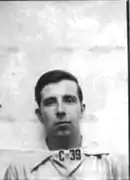Theodore A. Welton
Theodore A. Welton (July 4, 1918 – Nov. 14, 2010) was an American physicist best known as the co-author of the Fluctuation Dissipation Theorem.[1][2] During 1944 and 1945 he worked at Project Y in Los Alamos, New Mexico on nuclear weapons in Richard Feynman's T-4 Group[3] after being recruited by Feynman.
Theodore A. Welton | |
|---|---|
| Born | July 4, 1918 |
| Died | November 14, 2010 |
| Nationality | American |
| Occupation | Physicist |
| Known for | Fluctuation-dissipation theorem |

Welton was born in Saratoga Springs, New York and educated at the Massachusetts Institute of Technology, where he received at B.S. degree in 1939. He received his Ph.D. from the University of Illinois in 1944. He worked at Los Alamos National Laboratory on diffusion problems during the Manhattan Project and was present at the Trinity Test. After World War II he taught at MIT and the University of Pennsylvania. In 1950 he worked at Oak Ridge National Laboratory in the Theoretical Physics Division; and in the following year, with Herbert Callen, he published the landmark Fluctuation-dissipation theorem, showing that the explanations of Brownian motion and Johnson noise are specific examples of the more general theorem. Over the course of his career, Welton contributed to the development of nuclear reactors, and worked on particle physics and electron microscopy. He received a Humboldt Prize for his work in physics.
References
- H.B. Callen, T.A. Welton (1951). "Irreversibility and Generalized Noise". Physical Review. 83 (1): 34–40. Bibcode:1951PhRv...83...34C. doi:10.1103/PhysRev.83.34.
- "Theodore Allen Welton". www.ornl.gov. ORNL. Retrieved 29 August 2018.
- "Theodore A. Welton". www.atomicheritage.org. Atomic Heritage Foundation. Retrieved 29 August 2018.
Further reading
- https://www.oakridger.com/article/20101123/NEWS/311239994 Obituary
- https://www.scribd.com/doc/48928105/Ted-Welton-Memories-of-Richard-Feynman Physics Today, February 2007